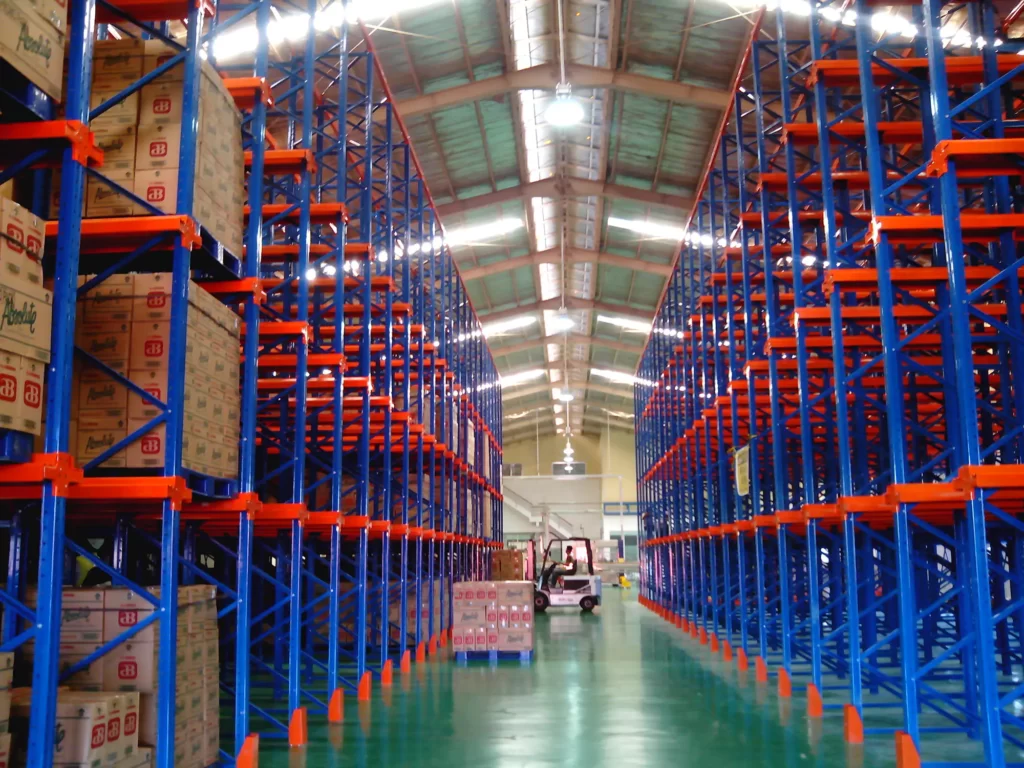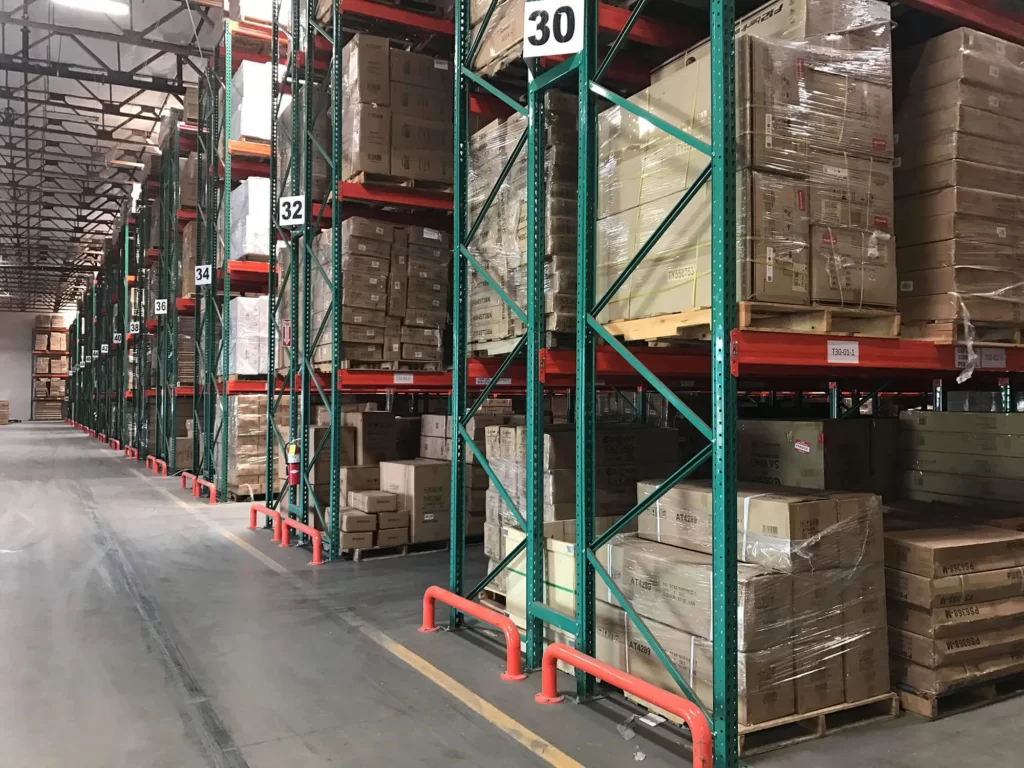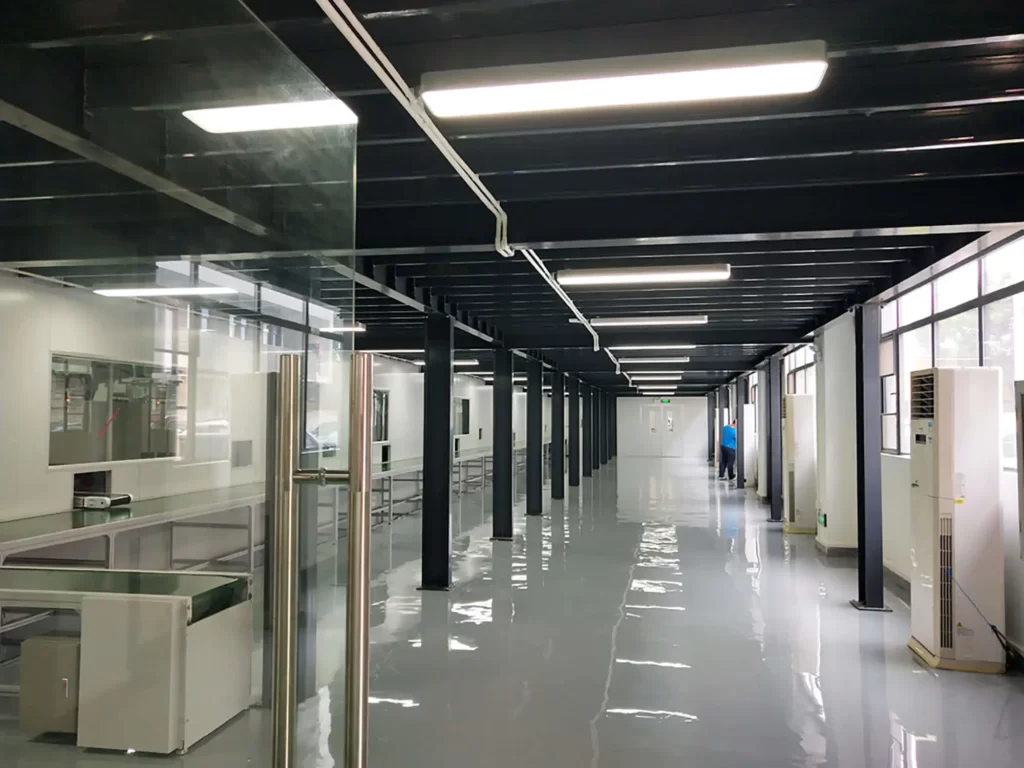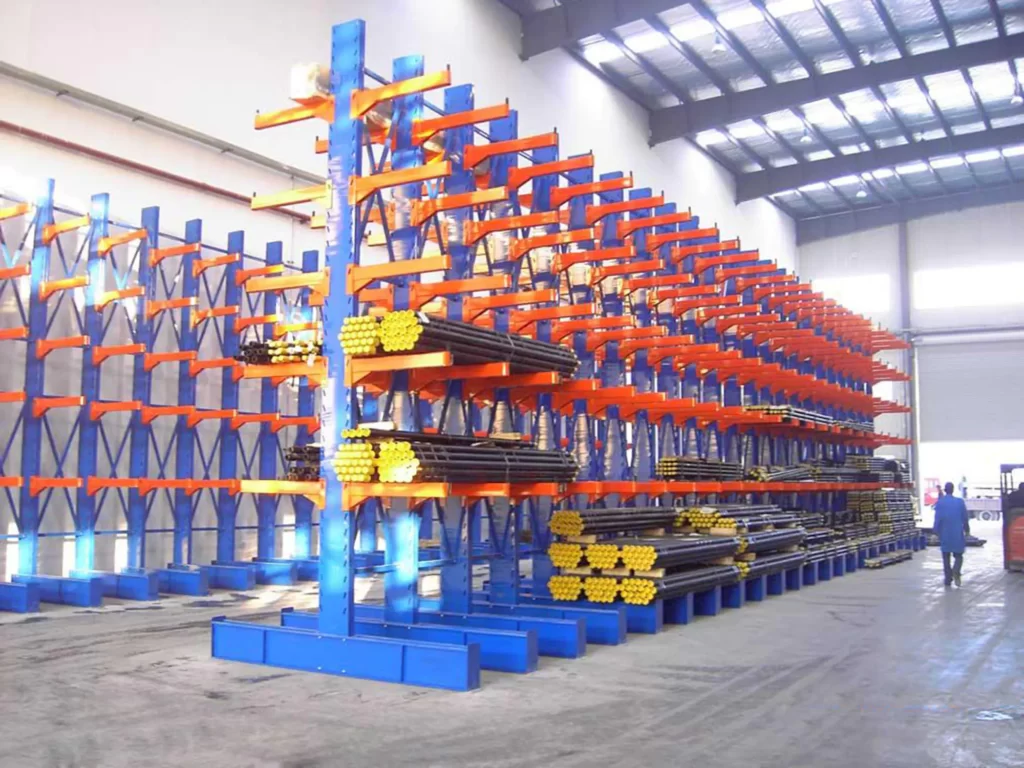Warehouse storage efficiency is critical for businesses to achieve maximum operational efficiency, cut costs, and meet customer needs. Warehouse storage that is appropriately organized and optimized can help reduce picking and packing times, minimize inventory errors, and improve overall productivity.
In this article, we will look at various warehouse storage ideas and solutions to assist businesses of all sizes in optimizing storage space, improving workflow, and increasing overall efficiency.
We will provide a detailed guide to assist you in developing an efficient and effective warehouse storage system, from utilizing vertical and horizontal space to implementing specialized and sustainable storage solutions.
Let’s start with assessing your storage needs.
1. Assessing Your Storage Needs.
Before implementing any storage solutions, assessing your warehouse’s unique storage needs is essential. This includes determining the volume and frequency of the expected inventory, identifying the size and weight of items, and analyzing workflow and accessibility requirements.
You should not ignore any environmental factors that may impact your inventory, such as temperature and humidity. Here is a step-by-step process to assess your storage needs.
a. Determining Inventory Volume and Frequency
Conducting an inventory audit is the first step in determining your warehouse’s storage needs. The audit should include an analysis of the volume and frequency of items to be stored. This will help you plan for any seasonal changes or fluctuations in demand, and you can use historical data to forecast future inventory needs and plan accordingly.
When conducting an inventory audit, it is essential to consider any changes in inventory that may occur in the future. This includes new products, changes in demand, and changes in supplier lead times. You should also consider the inventory turnover rate, as this can impact the type of storage solutions required.
b. Identifying Item Size and Weight
Identifying the size and weight of items that need to be stored is crucial to ensure that your storage solutions are adequate. When measuring the dimensions of items, you should also consider the dimensions of packaging and shipping materials. This is to be sure that there is enough storage space for all things and that they can be stored safely.
In addition, you should also consider any special requirements for items. For example, some items may require specialized storage solutions, such as those that are fragile, hazardous, or require climate control. By identifying these requirements upfront, you can ensure that the appropriate storage solutions are implemented.
c. Analyzing Workflow and Accessibility Requirements
The next step is to analyze workflow and accessibility requirements—it is critical to ensure that your storage solutions are efficient and effective. This includes evaluating the frequency of order picking and restocking to determine the most efficient storage locations. It is also essential to identify any bottlenecks in the workflow that can be addressed through improved storage solutions.
Accessibility requirements for different types of items should also be considered. For example, items that require easy access should be stored in an easily reachable location. Conversely, items that are stored long-term may require less accessible storage solutions.
d. Considering Environmental Factors
Environmental factors can significantly impact your inventory, and it is essential to consider these factors when assessing your storage needs. Heat and humidity can affect the storage requirements for certain types of items, and specialized storage solutions may be required. Secondly, it is equally important to consider the impact of dust, light, and other environmental factors on inventory and storage solutions.
By thoroughly assessing your warehouse’s storage needs, you can determine the most effective storage solutions and optimize your workflow for optimum efficiency.
After assessing the storage needs, let’s move towards adequately utilizing warehouse space. To begin with, how to maximize the vertical space in your warehouse?
2. Maximizing Vertical Space
When space is limited in your warehouse, making the most of the vertical space available is crucial. Maximizing vertical space can significantly increase your warehouse’s storage capacity and efficiency.
Here are some strategies to consider:
a. Utilizing Vertical Shelving and Racks
One of the most effective ways to maximize vertical space is using vertical shelving and racks. These storage solutions can be custom-designed to fit your warehouse’s unique needs and can be built up to the ceiling to make the most of available space. Vertical shelving and racks can also be tailored to provide easy access to items, reducing the time and effort required for picking orders.
b. Installing Mezzanines
Mezzanines are yet another excellent way to expand vertical space. Mezzanines are intermediary levels between the floor and the ceiling, providing extra storage space while taking up no floor space. Mezzanines can be built to meet the specific demands of your warehouse and utilized for storage, offices, or other purposes.
c. Implementing Vertical Carousels
Vertical carousels are a storage solution that rotates shelves vertically to bring items to the operator. This technique can save significant floor space while maximizing vertical space. Vertical carousels can be customized exclusively to fit your inventory and workflow requirements and can be integrated with your warehouse management system for easy order picking and inventory control.
d. Using Stacking Containers
Stacking containers is a versatile and cost-effective way to maximize your vertical space. These containers can be placed on top of each other, reducing the amount of floor space required for storage. They are available in various sizes and materials and can be easily tailored to fit your needs.
e. Considering Automated Storage Solutions
Automated storage solutions, such as automated storage and retrieval systems (AS/RS) and vertical lift modules (VLM), may dramatically boost the capacity and efficiency of your warehouse. These systems use vertical space to automatically store and retrieve things, decreasing the need for manual work while enhancing accuracy and speed.
3. Utilizing Horizontal Space
While maximizing vertical space is essential for warehouse storage, it’s also vital to utilize horizontal space effectively.
Here are some strategies you may consider:
a. Implementing Wide-Aisle Storage
Wide-aisle storage is a classic storage solution that allows for simple inventory access. You may make room for forklifts or other equipment to maneuver between the shelves by expanding the aisles between shelving units. This strategy is best suited for heavier objects that require physical or mechanical handling and warehouses with low ceilings or confined areas.
b. Adopting Narrow-Aisle Storage
Narrow-aisle storage is a more modern storage technique that maximizes horizontal space. Narrow-aisle storage reduces the aisle width between shelving units, creating more storage space while still allowing forklifts or other equipment to maneuver. This method is ideal for smaller items that can be stored densely and accessed with automated equipment. With this system, you can increase your storage capacity by up to 50% compared to the wide-aisle storage mentioned above.
c. Utilizing Mobile Shelving
Mobile shelving is a type of storage solution that lets you maximize horizontal space by compacting storage units. These shelving units can be mounted on wheels or rails and moved to create an aisle to access items. Mobile shelving is ideal for areas with limited space and can be customized to fit your warehouse’s needs. This method can improve your storage capacity by up to 100% compared to static shelving and boost your picking speed and accuracy.
d. Implementing Pallet Racking
Implementing pallet racking is one of the most effective ways to maximize your warehouse’s vertical space while also ensuring easy accessibility to your inventory. Various pallet racking systems, such as selective pallet racking, drive-in pallet racking, push-back pallet racking, and radio shuttle racking system, have unique advantages and applications.
Selective pallet racking is the most common type of pallet racking system. It allows for easy access to each pallet, making it an excellent choice for businesses that need to store a variety of products. On the other hand, drive-in pallet racking maximizes space by allowing you to store multiple pallets of the same product in a single lane. Push-back pallet racking is similar to drive-in racking but allows for greater selectivity and access to each pallet. Finally, pallet flow racking is designed to help manage inventory turnover by using a gravity flow system that automatically rotates stock based on the first-in, first-out (FIFO) principle.
Opting for any type of pallet racking can increase your storage capacity by up to 50% compared to traditional shelving and improve your organization and inventory management.
e. Using Cantilever Racking
Cantilever racking is a type of storage system that utilizes horizontal space by storing long, bulky items. The arms of cantilever racks extend from vertical supports, providing easy access to items without any obstructions. It is ideal for storing items such as lumber, pipes, or furniture. This method can increase your storage capacity for large, irregularly shaped items by up to 60% compared to traditional racking methods.
Utilizing these strategies to maximize horizontal space can significantly increase your warehouse’s storage capacity and efficiency, enabling you to meet your inventory needs and streamline your operations.
4. Optimizing Storage Efficiency
Efficient storage is critical to the success of any warehouse operation. Below, we look closely at some strategies to optimize your storage efficiency.
a. Implementing First-In, First-Out (FIFO) and Last-In, First-Out (LIFO) Methods
First-In, First-Out (FIFO) and Last-In, First-Out (LIFO) are inventory management methods that optimize the use of your storage space. FIFO ensures that the oldest products are picked and shipped first, reducing the risk of expired or outdated inventory. This method is ideal for perishable or time-sensitive items.
LIFO, on the other hand, prioritizes newer inventory, allowing you to move new items out of your warehouse swiftly. This method is ideal for items with longer shelf life or items that are not time-sensitive, such as hardware tools.
b. Categorizing Your Inventory
Categorizing your inventory can help you optimize your storage efficiency by grouping similar items together. You can order your inventory by size, weight, type, or other relevant criteria. By organizing your list, you can reduce the time and effort required to locate items, improving your picking speed and accuracy.
c. Using Barcode and RFID Technology
Barcode and RFID technology can help you optimize your storage efficiency by providing real-time information about your inventory. Barcode technology allows you to track your inventory by scanning barcodes on items, while RFID technology uses radio waves to identify and track items. Using technologies like these can reduce the risk of lost or misplaced inventory, improve your inventory accuracy, and streamline your operations.
d. Implementing Automated Storage and Retrieval Systems (ASRS)
Automated Storage and Retrieval Systems (ASRS) is a computerized storage and retrieval system that can help you optimize your storage efficiency by automating your inventory management. It uses robotic systems to store and retrieve inventory, reducing the time and effort required for manual handling. ASRS is ideal for high-volume, high-velocity operations and can significantly improve your picking speed and accuracy.
e. Analyzing Your Storage and Inventory Data
Analyzing your storage and inventory data can help you optimize your storage efficiency by identifying areas for improvement. You may monitor patterns and trends in your inventory turnover rate, pick accuracy, and other data. With this information, you can increase efficiency by optimizing your storage space and inventory management tactics.
By implementing these strategies to optimize your storage efficiency, you can significantly improve your warehouse operations and meet your inventory needs.
After planning to optimize storage efficiency, you will have to factor in another important element: the safety and security of human and otherwise resources.
5. Safety and Security Considerations
Ensuring the safety and security of your warehouse and its contents is critical to your business’s success. Here are some safety and security considerations to keep in mind.
a. Adequate Lighting
Proper lighting is essential for warehouse safety—it ensures that workers can see what they are doing and reduces the risk of accidents. Good lighting also deters theft and vandalism. To ensure adequate lighting, consider installing LED or high-intensity discharge (HID) lighting fixtures that provide bright, even illumination.
b. Fire Prevention and Suppression
Fire is a significant risk in any warehouse or storage system, and prevention is key. Implementing fire prevention measures such as regular equipment maintenance, keeping flammable materials separate, and storing hazardous materials appropriately can significantly reduce the risk of a fire. It is also important to have a fire suppression system in place, such as sprinklers or fire extinguishers, to quickly extinguish any possible fires.
c. Employee Safety Training
Employee training is required for warehouse safety. Employees should be taught about equipment operation, material handling practices, and safety protocols to limit the risk of accidents. Continuous training and refresher courses can also assist in reinforcing safety practices and keep personnel informed of any changes.
d. Access Control and Surveillance
You cannot ignore access control and surveillance like employee safety training—they are equally important to warehouse security. Implementing access control measures such as ID badges or biometric scanners can limit access to authorized personnel only. Surveillance systems such as cameras or motion detectors can help in deterring theft and vandalism and provide valuable evidence in the event of a security breach.
e. Regular Maintenance and Inspections
Similarly, regular maintenance and inspections are essential to maintaining a safe and secure warehouse. Equipment such as forklifts and conveyor systems should be inspected and maintained on a regular basis to ensure they are in good working order. Inspections should also be conducted to spot and address any potential safety hazards, such as loose or damaged shelving.
By prioritizing safety and security considerations in your warehouse, you can minimize risks and protect your employees as well as your inventory.
6. Sustainable Storage Solutions
It is the age of sustainability, becoming an increasingly important consideration in the warehouse industry. Implementing sustainable storage solutions benefits the environment and can lead to cost savings and increased efficiency.
Here are some sustainable storage solutions you may consider:
a. Green Building Practices
Green construction measures may drastically minimize your warehouse’s environmental effects. Energy-efficient lighting, insulation, and HVAC systems may all help minimize energy use and expenditures. Adding solar panels or other renewable energy sources can also assist in reducing the carbon footprint of your warehouse.
b. Recyclable and Renewable Materials
Another strategy to improve sustainability in your warehouse is to employ recyclable and renewable materials for storage solutions. Using reusable plastic bins or cardboard boxes instead of single-use packing materials, for example, can help in reducing waste. Selecting storage solutions made of sustainable materials such as bamboo or recycled steel can also assist in reducing the environmental effect of your warehouse.
c. Efficient Storage Systems
Efficient storage methods can also help with warehouse sustainability. By making optimal use of space, you may minimize the amount of energy required for lighting, heating, and cooling. High-density storage solutions, such as pallet racking or vertical carousels, can help optimize storage capacity while requiring less floor area.
d. Recycling and Waste Management
Establishing an effective recycling and waste management program can significantly reduce your warehouse’s environmental impact. Ensure that all employees know the recycling and waste management protocols and have access to appropriate recycling and waste disposal facilities. If possible, consider partnering with a recycling company to ensure that waste is disposed of responsibly and recycled whenever possible.
e. Transportation Efficiency
Reducing transportation-related emissions is another critical component of sustainable warehouse management. We recommend implementing practices such as consolidating shipments, optimizing delivery routes, and using fuel-efficient vehicles to minimize your warehouse’s transportation-related environmental impact.
7. Specialized Storage Solutions
Lastly, different industries have different storage needs. If your warehouse stores specialized items, you might need specialized storage solutions.
Below are some specialized storage solutions to consider:
a. Cold Storage
You may need a cold storage racking if your warehouse stores perishable items such as food, pharmaceuticals, or chemicals. Cold storage solutions can keep your items at the required temperature and humidity levels, making sure that they remain fresh and safe for consumption. There are several types of cold storage solutions, including refrigerated trucks, walk-in coolers, freezers, and blast freezers.
b. Hazardous Materials Storage
Similarly, if your warehouse stores hazardous materials, such as chemicals or flammable liquids, you need to comply with strict safety regulations. Hazardous materials storage solutions must meet certain standards to ensure the safety of employees and the environment. These solutions include specially designed storage cabinets, spill containment systems, and fire suppression systems.
c. Automated Storage and Retrieval Systems (ASRS)
As discussed in the paragraphs above, automated storage and retrieval systems (ASRS) can help improve warehouse efficiency and accuracy. ASRS uses computer-controlled systems to automatically store and retrieve items, reducing the need for manual labor. ASRS can be particularly useful in large warehouses where items must be stored and retrieved quickly and accurately.
d. Vertical Lift Modules (VLM)
Vertical lift modules (VLM) are a type of high-density storage system that can maximize storage capacity while minimizing the amount of floor space required. VLM uses computer-controlled systems to automatically store and retrieve items, reducing the need for manual labor. VLM can be handy in warehouses that store small items with high turnover rates.
e. Mezzanine Storage
Mezzanine storage solutions involve building a second level of storage space above the existing warehouse floor. Mezzanine storage can help to increase storage capacity without the need for additional floor space. They can be instrumental in warehouses with high ceilings but limited floor space.
By implementing specialized storage solutions in your warehouse, you can improve efficiency and safety while meeting the unique storage needs of your industry. Cold storage, hazardous materials storage, automated storage and retrieval systems, vertical lift modules, and mezzanine storage are all specialized storage solutions that may be appropriate for your warehouse.
Warehouse Storage Ideas: Concluding Thoughts
Effective warehouse storage is crucial for the smooth operation of any business. You may build a more efficient and secure warehouse environment by analyzing your storage needs, maximizing vertical and horizontal space, improving storage efficiency, and addressing safety and sustainability. By using specialized storage solutions such as cold storage, hazardous materials storage, automated storage and retrieval systems, vertical lift modules, and mezzanine storage, you can improve efficiency and safety while meeting the unique storage needs of your industry.
Remember, a well-organized and well-maintained warehouse can improve productivity, reduce costs, and ultimately lead to greater success for your business.








